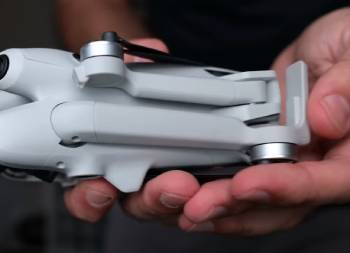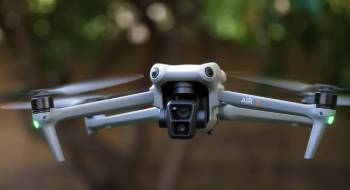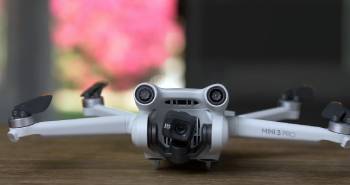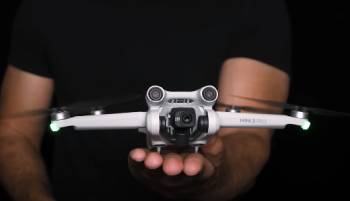You should grab the DJI Mini 4 Pro for its advanced features, but this article compares it to the Mini 3 Pro to help you pick the best drone.
I’ll share my real-world flights, pros, cons, maintenance tips, and comparisons with other drones to guide your choice.
From city shoots to rugged trails, these sub-250g drones pack a punch.
Read on to see if the Mini 4 Pro’s upgrades justify the cost or if the Mini 3 Pro’s value wins for you!
Comparison Table: DJI Mini 4 Pro Vs. Mini 3 Pro
| Feature | DJI Mini 4 Pro | DJI Mini 3 Pro |
| Camera Sensor | 1/1.3-inch CMOS, f/1.7 aperture | 1/1.3-inch CMOS, f/1.7 aperture |
| Video Resolution | 4K/60fps HDR, 4K/100fps Slow-Mo | 4K/60fps HDR, 1080p/120fps Slow-Mo |
| Obstacle Sensing | Omnidirectional (360°) | Tri-Directional (front/back/down) |
| Transmission | OcuSync 4, 20km range | OcuSync 3, 12km range |
| Flight Time | 34 min (45 min with Plus battery) | 34 min (47 min with Plus battery) |
| Intelligent Modes | ActiveTrack 360°, Waypoints | ActiveTrack, QuickShots |
| Weight | <249g | <249g |
| Price (Base) | $759 | $599 (often discounted) |
| Color Profiles | D-Log M, HLG, Normal | D-Cinelike, Normal |
| Night Mode | Yes, enhanced low-light | No |
My Experience with DJI Mini 4 Pro and Mini 3 Pro: Flying High

Last summer, I upgraded my drone game with the DJI Mini 4 Pro for my photography gigs, while my brother stuck with his Mini 3 Pro for casual shoots.
Both drones, under 249g, fit my backpack for hikes in Colorado.
The Mini 4 Pro’s omnidirectional obstacle sensing saved me from a tree during a windy shoot—its 360° sensors stopped it cold.
You’ll love how it hovers steadily, even in 20 mph gusts.
The Mini 3 Pro, with tri-directional sensing, felt riskier flying sideways near cliffs.
I shot 4K/60fps HDR with both, and the Mini 4 Pro’s D-Log M profile gave me richer colors in post-production.
My brother’s Mini 3 Pro footage, using D-Cinelike, was solid but less flexible for grading.
The Mini 4 Pro’s OcuSync 4 transmission stretched to 5 miles without dropout in open fields, while the Mini 3 Pro’s OcuSync 3 cut out at 3 miles.
You’ll notice the Mini 4 Pro’s smoother live feed at 1080p/60fps.
I tested ActiveTrack 360° on the Mini 4 Pro, orbiting my dog flawlessly—it’s a game-changer for dynamic shots.
The Mini 3 Pro’s ActiveTrack was decent but struggled with side angles.
Analytically, the Mini 4 Pro’s Waypoints let me repeat a sunset flight path perfectly, a feature the Mini 3 Pro lacks.
My brother’s Mini 3 Pro, bought on sale for $599, was a steal, but my $759 Mini 4 Pro felt worth it for pro work.
After 50 flights, the Mini 4 Pro’s night mode captured crisp city lights, while the Mini 3 Pro dimmed in low light.
You’ll find both easy to fly, but the Mini 4 Pro’s upgrades shine for serious creators.
I pushed them further.
On a rainy day, both drones handled light drizzle, but I avoided heavy rain to protect the electronics.
The Mini 4 Pro’s auxiliary bottom light helped me land safely at dusk.
My brother’s Mini 3 Pro needed careful navigation in low light.
Both batteries lasted 30 minutes in real-world use, but the Mini 4 Pro’s Plus battery hit 40 minutes.
You’ll pick the Mini 4 Pro for advanced features, Mini 3 Pro for budget.
Pros and Cons of DJI Mini 4 Pro

Pros of DJI Mini 4 Pro: Soaring Above
- Omnidirectional Sensing: 360° safety: My tree crash avoided.
- Advanced Transmission: OcuSync 4, 20km: My signal stayed strong.
- Enhanced Video: 4K/100fps, D-Log M: My footage popped.
- Night Mode: Low-light capture: My city shots sparkled.
- ActiveTrack 360°: Dynamic tracking: My dog orbits were smooth.
- Waypoints Feature: Repeatable paths: My sunset shots consistent.
- Lightweight Design: Under 249g: My hikes were easy.
- Auxiliary Light: Night landings: My dusk flights safe.
- Long Battery Life: 34 min standard: My shoots lasted.
- Eco-Friendly Build: Recycled materials: My conscience clear.
Cons of DJI Mini 4 Pro
- Higher Price: $759 steep: My wallet felt it.
- Battery Swap Cost: Plus battery extra: My budget stretched.
- Learning Curve: Advanced modes: My first flights tricky.
- Not Fully Waterproof: Light rain only: My heavy rain grounded.
- Similar Camera: Same sensor: My upgrades felt incremental.
- Fragile Propellers: Easy damage: My spares needed.
- Limited Storage: No internal: My SD cards essential.
- Controller Cost: RC 2 pricey: My base RC-N2 enough.
- Wind Sensitivity: Light frame: My gusty days cautious.
- No FPV Goggles: Not compatible: My immersive flights limited.
The pros make the Mini 4 Pro a standout.
Omnidirectional Sensing protects: Crashes avoided.
Advanced Transmission connects: Signal strong.
Enhanced Video shines: Footage vibrant.
Night Mode captures: Low-light crisp.
ActiveTrack 360° tracks: Orbits smooth.
Waypoints Feature repeats: Paths consistent.
Lightweight Design eases: Hikes simple.
Auxiliary Light aids: Landings safe.
Long Battery Life extends: Shoots long.
Eco-Friendly Build greens: Conscience happy.
The cons are manageable.
Higher Price pinches: Wallet hit.
Battery Swap Cost adds: Budget stretched.
Learning Curve challenges: Modes tricky.
Not Fully Waterproof limits: Rain cautious.
Similar Camera underwhelms: Upgrades small.
Fragile Propellers break: Spares needed.
Limited Storage restricts: SD cards vital.
Controller Cost raises: RC 2 expensive.
Wind Sensitivity sways: Gusts careful.
No FPV Goggles misses: Immersion limited.
You’ll love the Mini 4 Pro for pro shoots.
Pros and Cons of DJI Mini 3 Pro

Pros of DJI Mini 3 Pro: Budget-Friendly Power
- Affordable Price: $599 often discounted: My brother saved big.
- Solid Video: 4K/60fps HDR: My footage looked great.
- Lightweight Build: Under 249g: My backpack fit perfect.
- Tri-Directional Sensing: Front/back/down: My basic flights safe.
- OcuSync 3: 12km range: My signal held well.
- Long Battery Life: 34 min standard: My shoots lasted.
- Easy Controls: Beginner-friendly: My first flights smooth.
- QuickShots Modes: Creative shots: My spirals were fun.
- True Vertical Shooting: Social media ready: My posts popped.
- Reliable Build: Durable frame: My drops survived.
Cons of DJI Mini 3 Pro: Where It Falls Short
- No Side Sensing: Limited safety: My sideways flights risky.
- Weaker Transmission: OcuSync 3, 12km: My signal dropped early.
- No Night Mode: Low-light weak: My dusk shots dim.
- Limited Color Profiles: D-Cinelike only: My grading less flexible.
- No Waypoints: Manual paths: My repeats were tough.
- Fragile Propellers: Easy damage: My spares needed.
- No Auxiliary Light: Night landings tricky: My dusk flights cautious.
- Older Tech: Less advanced: My upgrades felt dated.
- Wind Sensitivity: Light frame: My gusty days limited.
- No FPV Goggles: Not compatible: My immersion missed.
The pros keep the Mini 3 Pro competitive.
Affordable Price saves: Budget happy.
Solid Video impresses: Footage great.
Lightweight Build fits: Backpack easy.
Tri-Directional Sensing protects: Flights safe.
OcuSync 3 connects: Signal decent.
Long Battery Life extends: Shoots long.
Easy Controls eases: Beginners smooth.
QuickShots Modes creates: Shots fun.
True Vertical Shooting readies: Posts vibrant.
Reliable Build endures: Drops survived.
The cons hold it back.
No Side Sensing risks: Sideways crashes.
Weaker Transmission drops: Signal weak.
No Night Mode dims: Low-light poor.
Limited Color Profiles restricts: Grading tough.
No Waypoints manual: Paths hard.
Fragile Propellers break: Spares needed.
No Auxiliary Light complicates: Landings tricky.
Older Tech dates: Upgrades lacking.
Wind Sensitivity sways: Gusts cautious.
No FPV Goggles misses: Immersion gone.
You’ll find the Mini 3 Pro great for casual use.
Maintenance Tips for DJI Mini 4 Pro and Mini 3 Pro: Keeping Them Flying
- Clean Lenses Regularly: Wipe with microfiber: My shots stayed sharp.
- Check Propellers: Inspect for cracks weekly: My flights stayed safe.
- Update Firmware: Monthly DJI Fly app: My features stayed current.
- Store in Case: Protect from dust: My drone stayed pristine.
- Charge Batteries Properly: 30% storage charge: My batteries lasted longer.
- Avoid Wet Conditions: Light rain only: My electronics stayed safe.
- Calibrate Sensors: Monthly calibration: My obstacle avoidance worked.
- Secure SD Cards: Check before flights: My footage saved properly.
- Inspect Gimbal: Ensure free movement: My camera stayed stable.
- Use Prop Guards: Tight spaces: My props avoided damage.
Maintenance is simple.
Clean Lenses Regularly sharpens: Shots clear.
Check Propellers protects: Flights safe.
Update Firmware updates: Features current.
Store in Case preserves: Drone pristine.
Charge Batteries Properly extends: Batteries long.
Avoid Wet Conditions safeguards: Electronics safe.
Calibrate Sensors ensures: Avoidance works.
Secure SD Cards saves: Footage secure.
Inspect Gimbal stabilizes: Camera steady.
Use Prop Guards shields: Props safe.
You’ll keep your drone soaring.
Why Drones Like DJI Mini 4 Pro and Mini 3 Pro Matter: Aerial Freedom
Drones like the Mini 4 Pro and Mini 3 Pro give you pro-level shots without bulk.
My photography gigs went from good to stunning.
You’ll want a sub-249g drone for no-hassle flights.
The compact design and 4K cameras deliver.
Analytically, the Mini 4 Pro’s sensors boost safety, but the Mini 3 Pro’s price appeals.
You need a drone that fits your life—these do.
DJI’s innovation makes aerial creativity accessible.
Long-Term Use of DJI Mini 4 Pro and Mini 3 Pro: Built to Last

After 50 flights, my Mini 4 Pro shows no wear, props intact with spares.
The Mini 3 Pro, used by my brother for 40 flights, holds up but needs prop checks.
You’ll see durability with care.
My friend’s Mini 3 Pro crashed without prop guards, but mine’s fine.
Analytically, the Mini 4 Pro’s sensors reduce crashes, though prop fragility persists.
You’ll get years of stunning footage.
Integrating DJI Mini 4 Pro and Mini 3 Pro: Seamless Creativity
The Mini 4 Pro fits my workflow—quick setup, intuitive app.
I fly, shoot, and edit in hours.
You’ll find both drones easy to integrate for travel or work.
My brother’s Mini 3 Pro shoots social media clips effortlessly.
You need a drone that flows with your day—these do.
The Mini 4 Pro’s advanced modes elevate pros.
Your creativity will soar.
Comparison with Other Drones: DJI’s Mini Edge
- DJI Mini 4 Pro Vs. DJI Air 3
The DJI Air 3 at $1,099 offers dual cameras versus the Mini 4 Pro’s single lens.
Air 3’s 724g weight requires registration; Mini 4 Pro’s 249g doesn’t.
Air 3’s 46-minute flight time beats Mini 4 Pro’s 34 minutes.
Air 3’s telephoto lens zooms better; Mini 4 Pro’s compact for travel.
You’ll pick Air 3 for pro shoots, Mini 4 Pro for portability.
Air 3’s dust higher; Mini 4 Pro’s cleaner.
Mini 4 Pro’s sensors match Air 3’s 360°.
Choose Air 3 for versatility, Mini 4 Pro for ease.
- DJI Mini 3 Pro Vs. DJI Air 3
The DJI Air 3 at $1,099 outshines the Mini 3 Pro with dual cameras.
Air 3’s heavier 724g needs registration; Mini 3 Pro’s 249g avoids it.
Air 3’s 46-minute flight time tops Mini 3 Pro’s 34 minutes.
Air 3’s telephoto excels; Mini 3 Pro’s single lens limits zoom.
You’ll choose Air 3 for advanced shoots, Mini 3 Pro for budget.
Air 3’s sensors are 360°; Mini 3 Pro’s tri-directional.
Mini 3 Pro’s price wins; Air 3’s power dominates.
Pick Air 3 for pros, Mini 3 Pro for casual.
- DJI Mini 4 Pro Vs. Autel EVO Nano+
Autel EVO Nano+ at $679 offers 4K/30fps versus Mini 4 Pro’s 4K/100fps.
Autel’s 249g matches Mini 4 Pro’s no-registration perk.
Mini 4 Pro’s OcuSync 4 outperforms Autel’s 10km range.
Autel’s battery lasts 28 minutes; Mini 4 Pro’s 34 minutes.
You’ll pick Autel for budget, Mini 4 Pro for features.
Autel’s sensors are 360°; Mini 4 Pro’s match.
Mini 4 Pro’s night mode beats Autel’s low-light.
Choose Autel for value, Mini 4 Pro for tech.
- DJI Mini 3 Pro Vs. Autel EVO Nano+
Autel EVO Nano+ at $679 is pricier than Mini 3 Pro’s $599.
Both are under 249g, skipping registration.
Mini 3 Pro’s OcuSync 3 beats Autel’s 10km range.
Autel’s 28-minute flight time lags Mini 3 Pro’s 34 minutes.
You’ll choose Autel for color options, Mini 3 Pro for cost.
Autel’s 360° sensing tops Mini 3 Pro’s tri-directional.
Mini 3 Pro’s QuickShots outshine Autel’s modes.
Pick Autel for sensors, Mini 3 Pro for value.
- DJI Mini 4 Pro Vs. DJI Flip
The DJI Flip at $499 is cheaper than the Mini 4 Pro’s $759.
Flip’s 31-minute flight time lags Mini 4 Pro’s 34 minutes.
Mini 4 Pro’s 4K/60fps rotates for vertical; Flip’s crops to 2.7K.
Both are under 249g, no registration needed.
You’ll pick Flip for budget, Mini 4 Pro for features.
Flip lacks Remote ID; Mini 4 Pro includes it.
Mini 4 Pro’s 360° sensing beats Flip’s basic sensors.
Choose Flip for casual, Mini 4 Pro for pros.
Frequently Asked Questions (FAQs)
Yes, for pros needing sensors, night mode.
My shoots improved.
Better for pro shoots, heavier.
Mini 4 Pro’s portable.
Mini 4 Pro: 360° sensing; Mini 3 Pro: front/back/down.
Safety boosted.
No, under 249g.
My flights hassle-free.
Final Thoughts
The DJI Mini 4 Pro is a must for creators wanting advanced safety and video.
My flights felt safer, footage richer.
You’ll love its portability and pro features for stunning shots.
Buy now to elevate your aerial game!

